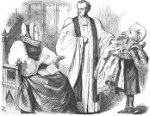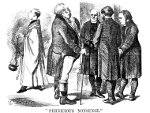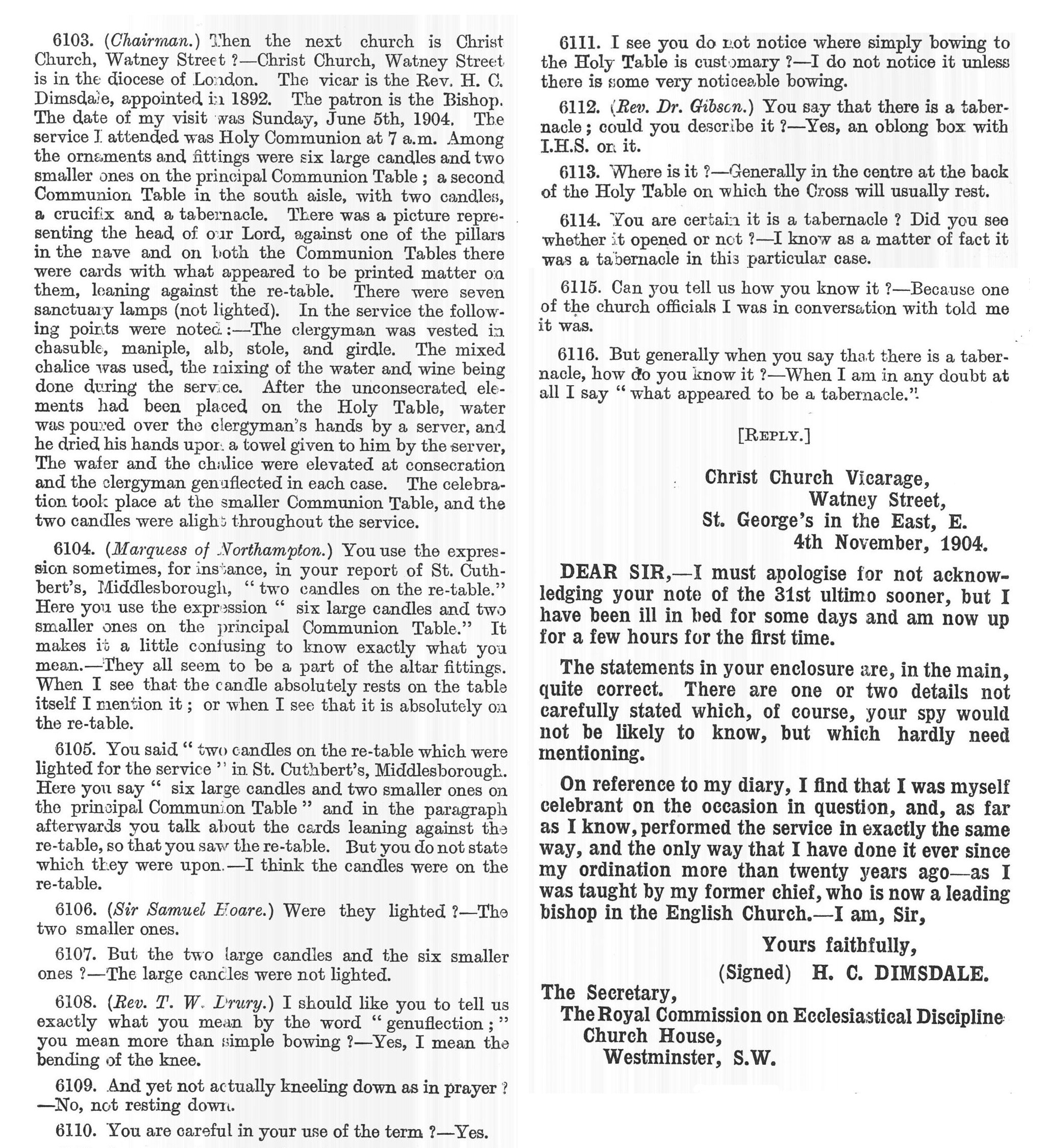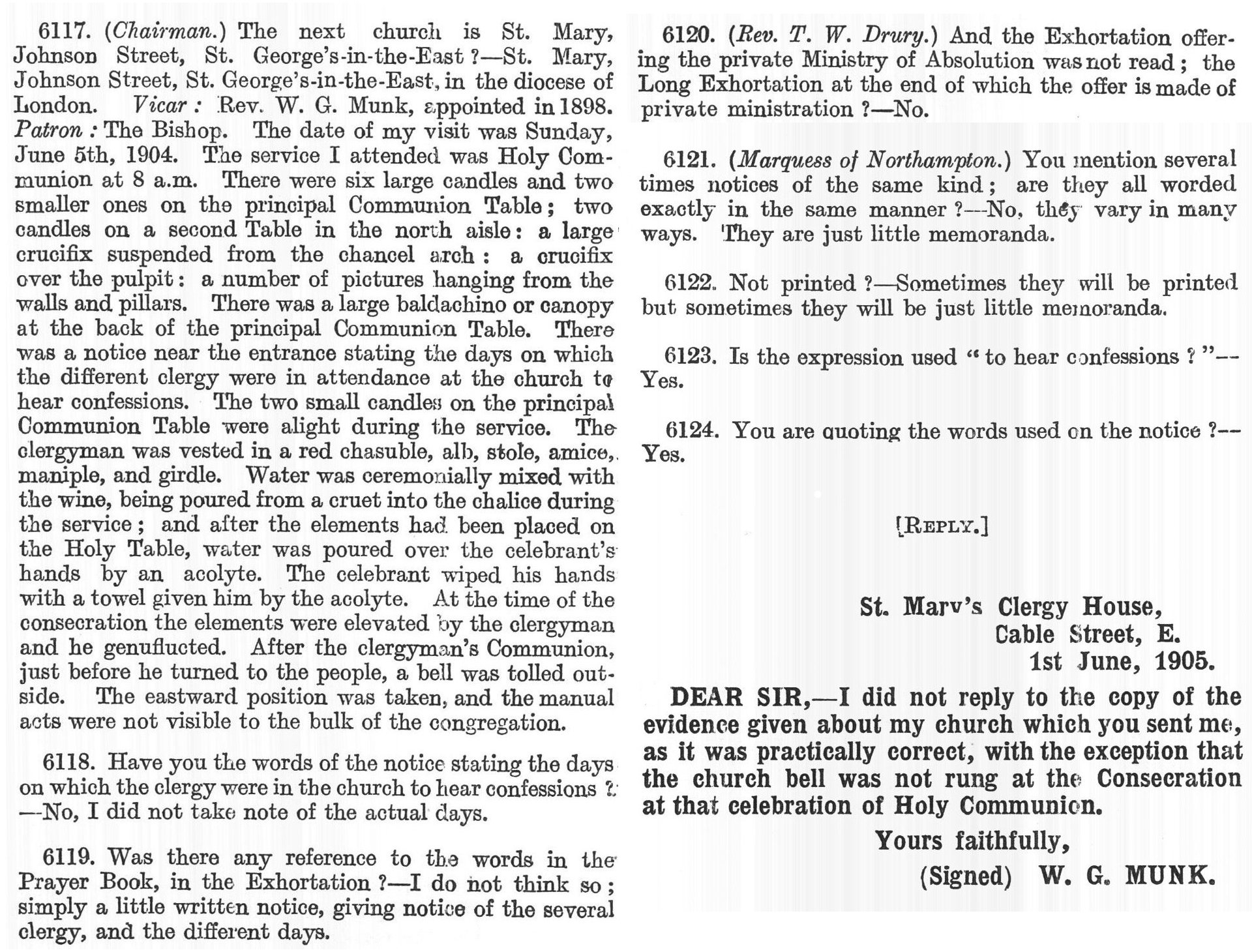Royal Commission on Ecclesiastical Discipline 1906
After the
Ritualism Riots of 1859-60, St George-in-the-East ceased to be a centre
of controversy over ritual and doctrine: the focus shifted elsewhere.
Even our 'advanced' daughter church of St Peter London Dock moved out
of the eye of the storm, once the Revd A.H. Mackonochie
had been moved on, to St Alban Holborn (where a prosecution was mounted
in 1867 based on the Church Discipline Act of 1840, and renewed under
the new act of 1874 - see below - reported as Mackonochie v. Lord Penzance (1881) 6 App Cas 424).

 A growing number
of parishes - especially, but not exclusively, in London and the
south-east (hence the jibe 'London, Brighton and South Coast religion')
- introduced patterns of worship, ceremonial, vesture and ritual
practices that were fiercely contested by Protestant organisations,
opposed by bishops, and mocked in the media [see Punch cartoons, right, from 1866 PERNICIOUS NONSENSE - and 1867 CHANGE FOR THE BETTER]
- though many of them, both in slum areas and in fashionable parts of
town, flourished as a result. In London, St Barnabas Pimlico and St
Paul Knightsbridge had been two centres of ritualism, and although the
incumbent of the latter, W.J.E. Bennett, had been forced out of office,
the catholic movement continued to take ground. (Bennett continued his
campaign from the parish of Frome-Selwood, with which a number of
clergy of this parish had connections over the years, and was to an
extent vindicated by the Court of Arches and Privy Council in 1872).
Legal challenges turned on the controverted interpretation of the 'ornaments rubric'
of the Book of Common Prayer, which ritualists argued not only allowed,
but required, many of their practices. Attempts to regulate were
largely unsuccessful, and in 1867 a Royal Commission
was appointed to inquire into and report upon different practices which
had arisen, and varying interpretations which were put upon the
rubrics, orders &c. It proved inconclusive, its only practical outcome being the approval of a revised scheme of readings for daily prayer (1871).
A growing number
of parishes - especially, but not exclusively, in London and the
south-east (hence the jibe 'London, Brighton and South Coast religion')
- introduced patterns of worship, ceremonial, vesture and ritual
practices that were fiercely contested by Protestant organisations,
opposed by bishops, and mocked in the media [see Punch cartoons, right, from 1866 PERNICIOUS NONSENSE - and 1867 CHANGE FOR THE BETTER]
- though many of them, both in slum areas and in fashionable parts of
town, flourished as a result. In London, St Barnabas Pimlico and St
Paul Knightsbridge had been two centres of ritualism, and although the
incumbent of the latter, W.J.E. Bennett, had been forced out of office,
the catholic movement continued to take ground. (Bennett continued his
campaign from the parish of Frome-Selwood, with which a number of
clergy of this parish had connections over the years, and was to an
extent vindicated by the Court of Arches and Privy Council in 1872).
Legal challenges turned on the controverted interpretation of the 'ornaments rubric'
of the Book of Common Prayer, which ritualists argued not only allowed,
but required, many of their practices. Attempts to regulate were
largely unsuccessful, and in 1867 a Royal Commission
was appointed to inquire into and report upon different practices which
had arisen, and varying interpretations which were put upon the
rubrics, orders &c. It proved inconclusive, its only practical outcome being the approval of a revised scheme of readings for daily prayer (1871).
Archibald Tait,
who as Bishop of London had played an ambiguous role in the Ritualism
Riots in this parish, became Archbishop of Canterbury, and in 1874
introduced a private member's bill into the House of Lords which
resulted in the controversial Public Worship Regulation Act,
which created new procedures for complaint - involving, to the horror
of many, secular courts; over the years it resulted in the imprisonment
of five clergy, and lay behind the prosecution of the saintly Edward King, Bishop of Lincoln, on ritualism charges in 1888, reported as Read v. Bishop of Lincoln [1892] AC 644.
In the closing years of the century, campaigns against 'ritual
lawlessness' flared up again (perhaps most notoriously with the various
editions of William Walsh's scurrilous Secret History of the Oxford Movement,
published by the Church Association), and 'opinions' issued by the
Archbishops against incense, processional lights and reservation of the
sacrament proved ineffective; so another Royal Commission was
established in 1904 to inquire into breaches or neglect of
the Law relating to the conduct of Divine Service and to
propose remedies.
It was an
extraordinarily thorough piece of work, whose evidence, in four volumes
with over 20,000 minuted questions, was presented two years later to
both Houses of Parliament. They received submissions from scholars and
interested parties, and considered detailed reports on services
attended by 'spies', or at least what modern websites call 'mystery worshippers'. Its broad
and unsurprising conclusion was that the law was too narrow to cope
with the growing diversity of Anglican practice, and that the machinery
for discipline had broken down; the text of report (but not the
detailed evidence) can be seen here.
But no particular action was taken (other than an end to prosecutions -
though the 1874 Act technically remained on the books until 1965).
The First World War intervened, and the next development was the
abortive movement for Prayer Book reform in the 1920s (with the
church's proposals rejected by Parliament in 1927 and 1928).
Report of local services
Some of the
'mystery worshippers' were members of various Protestant
societies, and therefore both biased and often spectacularly incorrect
in their descriptions of what they saw and described. Only two of 'our'
churches were reported on, Christ Church Watney Street, and St Mary
Cable Street, in both cases by William Norton Medlicott, who had been
asked by the commission to visit various churches, mainly in and
around London, and his descriptions are on the whole accurate. [Was he
the father of his namesake, a distinguished academic historian
(1900-87)?] There is also a report of an Ascension Day service at St Ethelburga Bishopsgate conducted by George Horlock, a former curate of St Paul Dock Street.
Clergy were invited to respond to the accounts of their
services: some offered point-by-point rebuttals, others refused to
engage with the process, but most - as in our two cases - agreed that
the reports were broadly accurate, adding that their practices were
well-established and lawful. As in Bryan King's time, it is certainly
the case that most of what some complained of at the time is perfectly
standard Anglican practice nowadays, in churches of nearly all
traditions.
Christ Church, Watney Street

The 'chief' whom he mentions was Dr Gott, from the Leeds Clergy School, later Bishop of Truro.
St Mary Cable Street

Back
to Christ Church Watney Street
| Back to History | Back to Ritualism Riots



 A growing number
of parishes - especially, but not exclusively, in London and the
south-east (hence the jibe 'London, Brighton and South Coast religion')
- introduced patterns of worship, ceremonial, vesture and ritual
practices that were fiercely contested by Protestant organisations,
opposed by bishops, and mocked in the media [see Punch cartoons, right, from 1866 PERNICIOUS NONSENSE - and 1867 CHANGE FOR THE BETTER]
- though many of them, both in slum areas and in fashionable parts of
town, flourished as a result. In London, St Barnabas Pimlico and St
Paul Knightsbridge had been two centres of ritualism, and although the
incumbent of the latter, W.J.E. Bennett, had been forced out of office,
the catholic movement continued to take ground. (Bennett continued his
campaign from the parish of Frome-Selwood, with which a number of
clergy of this parish had connections over the years, and was to an
extent vindicated by the Court of Arches and Privy Council in 1872).
Legal challenges turned on the controverted interpretation of the 'ornaments rubric'
of the Book of Common Prayer, which ritualists argued not only allowed,
but required, many of their practices. Attempts to regulate were
largely unsuccessful, and in 1867 a Royal Commission
was appointed to inquire into and report upon different practices which
had arisen, and varying interpretations which were put upon the
rubrics, orders &c. It proved inconclusive, its only practical outcome being the approval of a revised scheme of readings for daily prayer (1871).
A growing number
of parishes - especially, but not exclusively, in London and the
south-east (hence the jibe 'London, Brighton and South Coast religion')
- introduced patterns of worship, ceremonial, vesture and ritual
practices that were fiercely contested by Protestant organisations,
opposed by bishops, and mocked in the media [see Punch cartoons, right, from 1866 PERNICIOUS NONSENSE - and 1867 CHANGE FOR THE BETTER]
- though many of them, both in slum areas and in fashionable parts of
town, flourished as a result. In London, St Barnabas Pimlico and St
Paul Knightsbridge had been two centres of ritualism, and although the
incumbent of the latter, W.J.E. Bennett, had been forced out of office,
the catholic movement continued to take ground. (Bennett continued his
campaign from the parish of Frome-Selwood, with which a number of
clergy of this parish had connections over the years, and was to an
extent vindicated by the Court of Arches and Privy Council in 1872).
Legal challenges turned on the controverted interpretation of the 'ornaments rubric'
of the Book of Common Prayer, which ritualists argued not only allowed,
but required, many of their practices. Attempts to regulate were
largely unsuccessful, and in 1867 a Royal Commission
was appointed to inquire into and report upon different practices which
had arisen, and varying interpretations which were put upon the
rubrics, orders &c. It proved inconclusive, its only practical outcome being the approval of a revised scheme of readings for daily prayer (1871).
